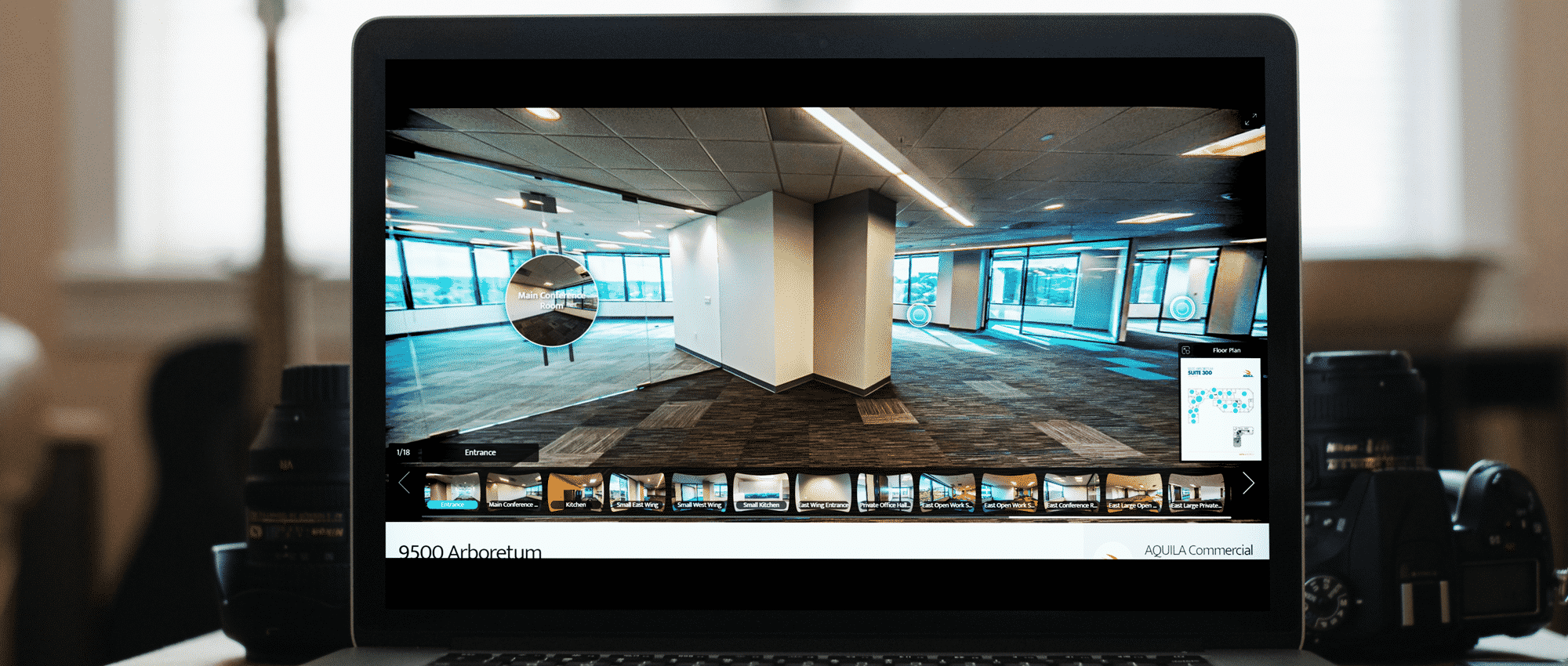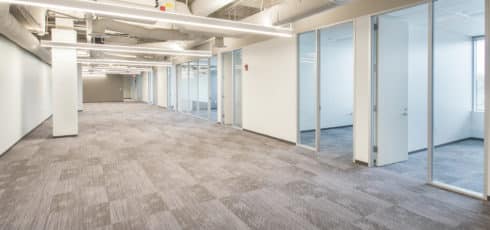Are you looking for a way to make your property stand out in the decision-making process?
At AQUILA we market hundreds of properties and are pivoting to help our clients stand out. We have found that one of the most effective ways to showcase properties is through virtual tours (also known as 360 tours). These virtual tours are especially important during COVID-19 as some in-person property tours have been limited.
Read Next: The Ultimate Guide to Commercial Real Estate Marketing
Creating a virtual tour for your property can help keep your property top of mind for prospects looking for new space.
- What types of properties can benefit from virtual tours
- Benefits of using virtual tours
- The difference between virtual tours and property tours
- How to produce virtual tours
- How much virtual tours cost to produce
What Type of Properties Can Benefit from Virtual Tours?
Generally, virtual tours are best for spaces that are camera-ready with fresh paint and carpet. This includes spec suites, whitebox space, move-in ready space, and sometimes shell space. A 360 photo shows every aspect of a space, so older second-gen spaces that need a lot of TI don’t always present well in this format.
Read Next: Should You Build a Spec Suite at Your Office Building?
Virtual property tours work best for featuring individual suites or spaces. Trying to show multiple suites in one tour can be confusing and overwhelming for the user. Another option is to do a tour of the property as a whole – focusing on common areas and amenities, rather than suites.
A virtual tour can also work well for single-user, stand-alone buildings.
If you are subleasing your space, a virtual tour can be a great way to get your space in front of prospects.
Benefits of Using Virtual Tours
Get Your Property on the Short List
When prospects are searching for new space, their tenant representation broker will conduct a market survey to show their client the options available in the market. The tenant will then narrow down this list into a “shortlist” that can consist of anywhere from 10 to 15 properties, which they will then go out and tour alongside their broker.
Because of COVID-19 and social distancing, tenants are being far more selective in which properties they choose to tour. For the most part touring hasn’t completely stopped, however instead of going out to a dozen properties, tenants are choosing only a select few in order to minimize their overall exposure and interactions. By allowing the tenant to see your space virtually, you may be more likely to make it onto their shortlist. This is because they already have had a chance to see the potential your property has.
Read Now: How to Tour Office Space Safely: Best Practices for Brokers and Tenants During and After COVID-19
Keep Your Property Top of Mind
A virtual tour is an easy and accessible way to keep your property top of mind for prospects. These tours allow them to “walk” the property and truly experience it without leaving their computer. These visuals will stick in their mind, making them more likely to end up on their shortlist.
This also means it will be fresh in their mind during the decision-making processes and can easily be referenced when deciding between properties.
Easily Connect With Out-Of-Town Prospects
If you have out-of-town prospects, a virtual tour makes it easier for them to experience the property. Normally they would have to either rely on photographs or travel to see the property in person. Even if they can tour the property in person, the virtual tour can be helpful to reference later when they do not have access to the space.
This can also be helpful if a tenant needs approval from out-of-town executives.
This is especially valuable in a city like Austin where companies are often looking to relocate or expand from another city.
Do Virtual Tours Replace Property Videos?
A virtual tour doesn’t replace a video tour. These types of media each serve different purposes.
Read Now: Why You Need to Use Video to Market Your Property During COVID-19
A property video is meant to grab a viewer’s interest and play into their emotions. This type of media is generally used early in the sales cycle to gain awareness about your property. It should tell a story about the space and show off the highlights. There are usually captions, a voice-over, or both, telling the story of the property and the opportunity and guiding the viewer’s experience.
Virtual tours are a sales tool that come into play later in the sales cycle and help in the decision-making process. They can be sent during the shortlisting process or after an in-person tour to help the prospect remember different important aspects of a space. These are a more practical tool that can help the prospect make a decision. As opposed to the video, a virtual tour is led by the viewer and shows the space in its raw form, showing off both its best features and its flaws.
Virtual tours can also serve as a substitute for a tour if the prospect is out of town or sick.
Virtual tours and video tours are not meant to be used interchangeably, but they can be very powerful when used together in the sales process.
How to Produce a Virtual Tour
Before You Get Started
Before you create a virtual tour, you need to be sure you have all the necessary equipment including:
- 360 camera
- Virtual tour software
- 360 tripod with extension pole
- Smartphone or tablet
- Someone to facilitate the shoot
AQUILA PRO TIP
360 Tour Technology
At AQUILA, we use a Ricoh Theta Z1 camera along with a Manfrotto Virtual Reality Kit that includes a 360 tripod. The software we use for your tours are Kuula.co and Ricoh Tours.
Best Practices
Make sure you schedule a time to photograph the space when no one is in the office and the office is tidy.
On the day of the shoot, always first walk the space and clear clutter. Make sure to open all blinds and doors, turn on all lights, and stage the space to make it look presentable.
Envision your tour and make a plan before you start shooting. Determine where you want to start and end the tour before you begin. It’s also important to make sure each photo transitions smoothly to the next. You need to make sure a door or entry point is visible in the shot to make the transitions flow.
How Much Does it Cost to Produce a Virtual Property Tour?
With virtual tours, you have two options: produce your tours in-house or outsource them. Next, we will break down the costs of each option.
Cost to Produce In-House
Cost of Camera
The cameras used for virtual tours are called 360 cameras. The most popular camera brands include Matterport, Ricoh, and QooCam, and the price of these cameras can range anywhere from $400 to $4000. You will pay more for cameras that shoot higher-resolution images and have more capabilities.
Cost of Software
Similar to the camera, the software used to create virtual tours also varies. The prices range from $12 per month to $300 a month, depending on the number of features, ability to customize, and ease of use. The leading software in the industry are Ricoh and Matterport. Matterport is more expensive and time-consuming, however, it provides a Google Streetview-style navigation that many users are familiar with. It also provides a “doll house” view of the space. Ricoh, on the other hand, is easy to learn, quick to produce, and less expensive. There are also other software options such as Kuula that allow more customization of graphics and the overall tour experience.
Time
Time is valuable, but virtual tours do not take long to shoot. It can take anywhere from 30 minutes to two or more hours to photograph a tour, depending on how big the space is and what software you’re using. Ricoh Tours is by far the fastest program, and Matterport is typically the most time-consuming.
For example, using the Ricoh Tours app in a small suite should only take about 20 to 30 minutes. On the other hand, a full floor or building can take several hours when using one of the other software.
Cost to Outsource
If you don’t want to shoot virtual tours in-house, you can hire an agency instead. These services are usually priced on a per square foot basis, similar to test fits. Some charge a base fee up to a certain size, then per square foot after that. The typical price we see is 10 to 25 cents per square foot.
If you hire a commercial leasing team, you may not have to worry about shooting it yourself or hiring an agency. Some brokerages offer this as an in-house service as a part of their marketing toolkit.
If you want to learn more about the power of virtual tours, schedule a consultation with AQUILA’s commercial leasing team today.
To continue learning about marketing your property check out these articles:
- Best Places to Advertise Your Commercial Property
- Best Branding Agencies for Commercial Real Estate Property
- Guide to Building an Effective Marketing Center for Your Commercial Property
- How to Market a Commercial Property: Essential Tools Your Leasing Firm Should Provide














